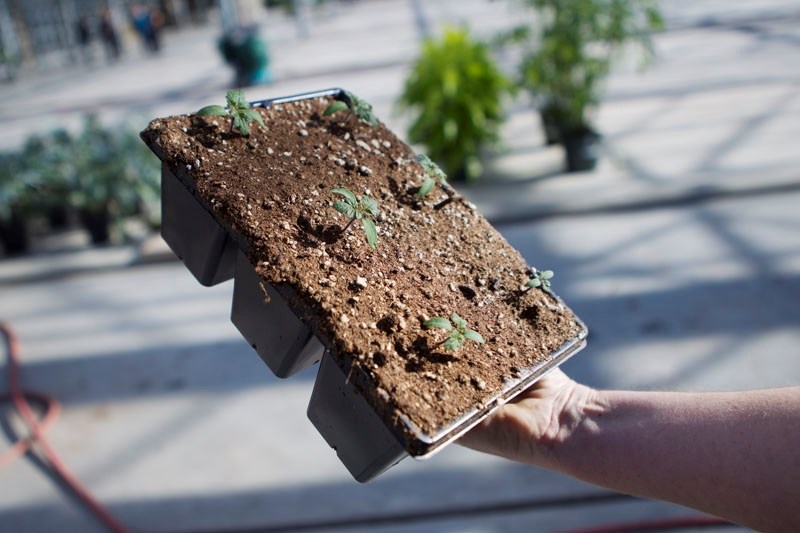The joy of seeing a tomato seedling sprout, even though the snow is still piled high outside, is worth the price of a packet of seeds. Getting the plants to flourish, and actually produce fruit is quite another thing, but when it happens, it’s certainly worthy of an atta-girl point or two.
The trick to success is in the timing, because if you sow tomatoes too early, you will have tall, gangly-looking plants. In addition, the gardener has to pay attention to the amount of light the plants need as well as to the temperature in the place where they are grown.
“It’s tough to grow tomatoes in a home environment. The key is, don’t jump the gun. Unless you have a greenhouse, it’s better to wait a few weeks to get your seedlings started,” said Jim Hole of the Enjoy Centre.
The Enjoy Centre has already seeded some tomatoes, but Prairie Gardens and Greenhouses will wait until the third or fourth week of March to start theirs.
Tam Andersen, of Prairie Gardens provided the following list as a rule of thumb for gauging how long it will take from seeding tomatoes until harvest:
• Early Girl (staking tomato): 52 days
• Yellow Pear (staking tomato): 57 days
• Black Cherry (staking tomato): 60 days
• Juliet (staking tomato): 72 days
• Sweet 100 (staking tomato): 62 days
• Tigerella (bush tomato): 65 days
• Green Zebra (bush tomato): 72 days
Tomato seeds need heat for germination, so put the planting trays on top of the fridge. To help keep them humid, cover them with plastic.
“The seed will not germinate if it sees the light so the seeds must be covered with soil. I plant my seeds in a soil-less mixture, because tomatoes are very sensitive to residual chemicals in soils that may come from a field,” said Andersen as she explained that she sets the seeds in trays of pre-moistened soil that is wet enough to form a ball if squeezed between her fingers, but not so wet that it drips.
The seedlings will sprout in 10 to 14 days and then they must be moved from the heat into a cool, bright place.
“Once they germinate you have to cool them down. If you have a cool, well-lit place, that’s perfect for tomatoes,” said Hole, who suggested the best post-germination growing temperature would be between 14 and 16 C.
If the basement is the coolest place in your house, consider putting the plants under fluorescent lights placed two or three inches above the plants.
As the plants develop, they need to be continually transplanted into deeper and deeper pots.
“The pot should be proportionate to the plant size. Once the first true leaves develop, it’s time to transplant and then bury them right up to their chins (the seed leaves). The plants will root along the stem, and you keep repeating this planting/burying process,” Andersen said, as she also warned against pruning the top of tomato plants.
“A tomato plant emerges from the seed that it is grown from with all of its fruit clusters already formed. When they get too tall, which they will in low light situations, it’s better to transplant them into a deeper pot and sink them as deep as you can in the soil. It will create a new set of roots and the tops and the fruit clusters will keep on growing,” she said.
At the beginning of May the plants need to be taken outside in their pots and placed in the shade during the day to get them used to cooler temperatures. Until the risk of frost has passed, they need to be taken inside again each evening.
Tomatoes can be grown on the deck in patio pots, but they need constant and regular watering. If you plant them in the garden, consider placing them horizontally in a trench, with just their upper tips above the soil. This method of planting strengthens the stems.
Though planting should be postponed for a few weeks, purchase the seed early, because the best varieties tend to disappear from store shelves quickly.
Look for the words “determinate” or “indeterminate” on packages.
“Determinate means it’s a bush type. It’s determined to be a certain height and won’t need staking. The indeterminate ones need staking, but the advantage is they often have a higher fruit quality because the branches are up off the ground,” Andersen said.
If you fancy a tomato sandwich from your own home-started, home-grown tomatoes, look for beefstake, big beef, starfire, cluster grande or early girl. If you want a cherry tomato, consider brandywine, sweet 200s, sun gold, yellow pear and black cherry. For a really juicy tomato, plant tigerella, which is red with an orange stripe. If you want to make good old salsa, look for the good-old Roma variety of tomato. For something different, look for the blue and black varieties. Osu blue tomato, which was developed at Oregon State University, is said to have a higher quantity of antioxidants than most tomatoes, and if it gets enough sunlight, the fruit will be indigo in colour.




